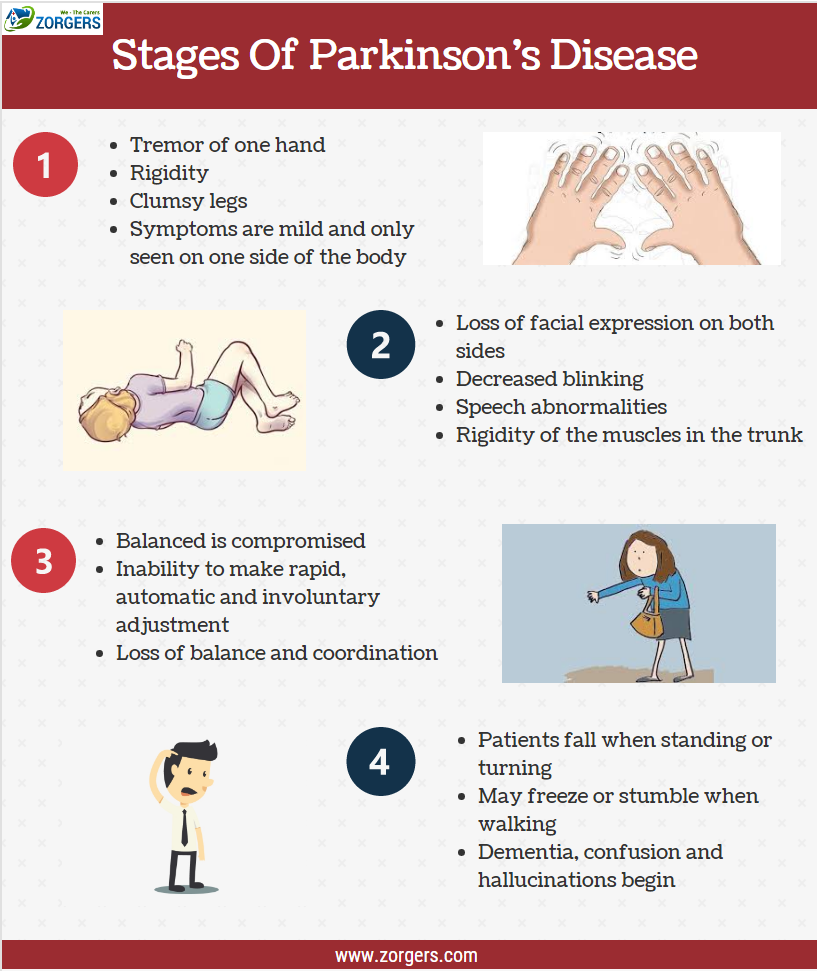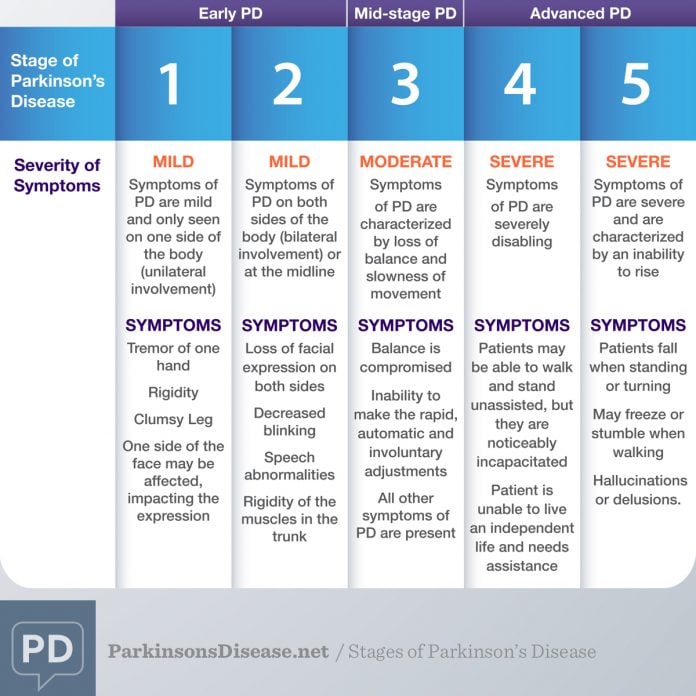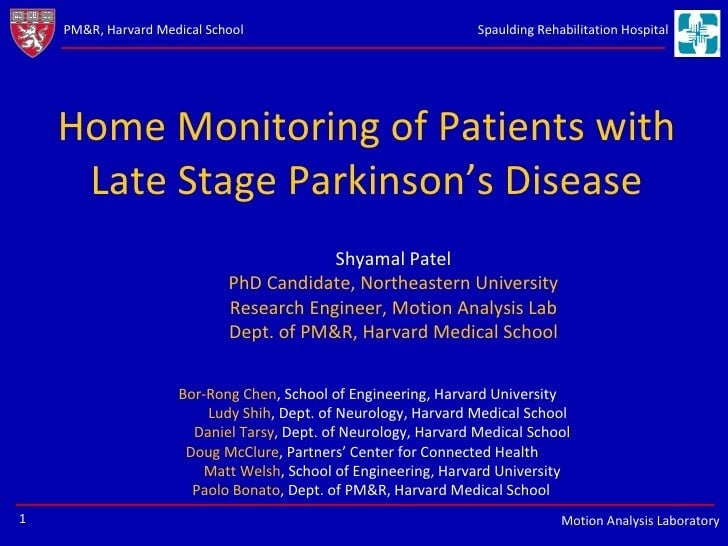How Long Does It Take Parkinsons Disease To Progress
In most cases, symptoms change slowly, with substantive progression taking place over the space of many months or years. Many people with PD have symptoms for at least a year or two before a diagnosis is actually made. The longer symptoms are present, the easier it is to predict how a person with PD will do over time.
Parkinsons Disease Life Expectancy
Most people with Parkinsons can have a normalor close to normallife expectancy today, thanks to new medications, therapies, and other treatments. Survival rates for those with typical Parkinsons disease are either the same as for the general population or shortened by about a year, studies show.
Risk factors for earlier mortality with Parkinsons include:
-
Being diagnosed before age 70
-
Having cognitive impairment early in the disease
-
Developing Parkinsons dementia
People with Parkinsons dont die from the disease itself, but from associated complications, such as infections or injuries . Cardiovascular disease is another common cause of death.
Treatments and lifestyle improvements, can help forestall cognitive decline, lower your risk of falls and strengthen your cardiovascular system. These can help improve your quality of life and, by slowing progression of the illness, potentially keep you living longer.
Researchers are continuing to explore new treatments that they hope will one day lead to better therapies for Parkinsons, which will result in an improved prognosis.
Managing The Terminal Phase
When the terminal phase can be anticipated by an acceleration in the patients global deterioration, a decision may have been taken with the patient and family not to treat further episodes of infection. A careful check for specific symptoms should be sought from the patient directly or from observing the patient for any signs of distress. Close family members will often recognise signs of unspoken distress. The views of experienced clinical staff may determine if the patient is frightened, in pain or has different nursing requirements.
For patients unable to swallow in the terminal stage, medication can be administered subcutaneously as needed or continuously using a syringe driver. Medication can be given, if necessary, to relieve specific symptoms as follows:
-
midazolam for fear or agitation
-
hyoscine butylbromide for drooling or chesty secretions
-
morphine for pain
If pain is present, a sufficient dose of morphine should be used to relieve it but without causing undesirable opioid side effects.
Read Also: Dap Test For Parkinson’s
Causes Of Parkinsons Disease
Parkinsons disease is caused by a loss of nerve cells in part of the brain called the substantia nigra. This leads to a reduction in a chemical called dopamine in the brain.
Dopamine plays a vital role in regulating the movement of the body. A reduction in dopamine is responsible for many of the symptoms of Parkinsons disease.
Exactly what causes the loss of nerve cells is unclear. Most experts think that a combination of genetic and environmental factors is responsible.
Read Also: Diseases Similar To Parkinsons
Talk With Others Who Understand

MyParkinsonsTeam is the social network for people with Parkinsons disease. On MyParkinsonsTeam, more than 89,000 members come together to ask questions, give advice, and share their stories with others who understand life with Parkinsons.
Are you or someone you care for living with Parkinsons disease? Share your experience in the comments below, or start a conversation by posting on your Activities page.
You May Like: Wallets For Parkinson’s Patients
A Guide To Understanding End
Crossroads Hospice & Palliative Care created guidelines to help family caregivers better understand the physical changes of the end-of-life process, as well as the emotional and spiritual end-of-life changes taking place.
The following describes the physical symptoms you may observe. Here are end-of-life signs and helpful tips:
What Is Parkinsons Disease
Parkinsons disease is the second most common neurodegenerative disorder and the most common movement disorder. Characteristics of Parkinsons disease are progressive loss of muscle control, which leads to trembling of the limbs and head while at rest, stiffness, slowness, and impaired balance. As symptoms worsen, it may become difficult to walk, talk, and complete simple tasks.
The progression of Parkinsons disease and the degree of impairment varies from person to person. Many people with Parkinsons disease live long productive lives, whereas others become disabled much more quickly. Complications of Parkinsons such as falling-related injuries or pneumonia. However, studies of patent populations with and without Parkinsons Disease suggest the life expectancy for people with the disease is about the same as the general population.
Most people who develop Parkinsons disease are 60 years of age or older. Since overall life expectancy is rising, the number of individuals with Parkinsons disease will increase in the future. Adult-onset Parkinsons disease is most common, but early-onset Parkinsons disease , and juvenile-onset Parkinsons disease can occur.
Read Also: Parkinson’s Disease And Urinary Incontinence
Wearing Off More Troublesome Than Dyskinesia
The treatment of wearing off is based around providing more continuous delivery of dopaminergic medications and the more prolonged stimulation of post-synaptic dopamine receptors . Classical approaches to the treatment of wearing off involve increasing the dose and frequency of L-dopa administration, fractionation of L-dopa doses and multiple administrations, the introduction of sustained release forms of L-dopa, the use of rapid action forms of the drug through liquid suspensions or soluble pro-drug forms . Renewed interest in L-dopa as first line therapy has led to the development of a number of new delivery forms, including gastro-retentive and sustained release formulations, which are currently in clinical development . One recently approved formulation in the USA is IPX-066 which uses microspheres of different sizes to deliver L-dopa at different rates to provide a faster and more prolonged clinical response. In early and late stage patient populations, IPX-066 increases the daily duration of on by approximately 3h compared to immediate release L-dopa and 1.5h compared to Stalevo . In the longer term, replacement of dopamine in the basal ganglia may be possible using gene therapy that inserts the key genes for dopamine production in to the striatum. One viral vector based approach showing signs of success is ProSavin that has completed early stage clinical trial .
Table 2 Existing and novel approaches to the treatment of wearing off
What Is The Prognosis For Someone With Early
One of the challenges of early-onset Parkinsons disease is that you will inevitably live longer with the condition, as Parkinsons alone is not fatal. Early-onset Parkinsons disease does not always present the same way as late-onset Parkinsons disease, and there is no definite prognosis. Younger Parkinsons patients may be more at risk of developing non-motor symptoms, such as depression, sleep disorders, anxiety and urinary issues, which can cause health complications as the disease progresses.
However, early-onset patients also show slower disease progression, and it can take years to move between stages. Each case of Parkinsons is reviewed on an individual basis, so only your doctor can tell you your prognosis.
Don’t Miss: Parkinson’s Deep Brain Stimulation Device
Stage One: Symptoms Affect Only One Side Of Your Body
The initial phase of Parkinsons disease typically presents with mild symptoms. Some patients will not even detect their symptoms in the earliest phases of this stage. Typical motor symptoms experienced in Stage One include tremors and shaking limbs. Family members and friends may begin to notice other symptoms including tremor, poor posture, and mask face or loss of facial expression.
My Parkinson’s Story: Advanced Parkinsons
This 10-minute video alternates between an interview with a man and his wife and his palliative care team, including a doctor, nurse, clerg and social worker. The man and his wife shares his experience with late stage Parkinson’s. The palliative care team explains that their job is to support the best physical, emotional and spiritual wellbeing of the immediate family as well as help the family make end of life decisions.
You May Like: Night Terrors Parkinson’s Disease
How To Manage Symptoms At The End Of Life
At the end of life, good practice is to plan for any potential symptoms that may arise. The most common symptoms anticipated are pain, dyspnoea, nausea and vomiting, agitation, anxiety, delirium and noisy respiratory secretions.18 For patients with PD particular considerations should be given to the more commonly used medicines, specifically anticholinergics and antidopaminergics. These are usually prescribed for treatment of respiratory secretions and nausea and vomiting. Alternatives are available for respiratory secretions, and include glycopyrronium, in preference to hyoscine hydrobromide. Although this is an anticholinergic, only a small proportion crosses the blood brain barrier.
For nausea and vomiting, ondansetron,19 cyclizine, domperidone have all been suggested in PD.20 However, ondansetron has been shown to be inferior to domperidone in the pre-treatment of apomorphine.21 Cyclizine has anticholinergic properties and may exacerbate confusion, especially when comorbid psychosis or cognitive impairment are present. Levomepromazine, although it has antidopaminergic effects, has been shown to be effective for nausea with rotigotine in a case report.22
Agitation, dyspnoea and pain can all be managed with the same anticipatory medications as recommended.20 Specifically relating to PD, several case reports have supported the intraoperative use of midazolam, during sedation, for tremor and dyskinesias,23,24 as well as for agitation at the end of life.20
When To Seek Hospice Care

When you or your loved one have a life expectancy of six months or less, you become eligible for hospice care a type of comfort care provided at the end of life for someone living with end-stage Parkinsons disease. Hospice provides extra support so your loved one can live as comfortably as possible.
If you have experienced a significant decline in your ability to move, speak, or participate in activities of daily living without caregiver assistance, its time to speak with a hospice professional.
Read more: What is hospice care?
Some of the things that determine whether your loved one with end-stage Parkinsons is eligible for hospice include: difficulty breathing, bed bound, unintelligible speech, inability to eat or drink sufficiently, and/or complications including pneumonia or sepsis.
If you live in South Jersey, our nurse care coordinator can answer your questions and decide if your loved one is ready for hospice care. Call us 24/7 at 229-8183.
Recommended Reading: How Long Does It Take To Diagnose Parkinson’s
Complications In Advanced Pd
While worsening of motor function and drug-induced motor complications represents a major challenge in patients with mid-stage to advanced disease, in the advanced stage of PD the most troublesome and distressful complications are usually nonmotor symptoms, including psychiatric and cognitive disorders, autonomic disturbances, and sleep disorders that significantly increase the need for supportive care. Unfortunately, these symptoms are frequently neglected in clinical practice due to limited consultation time, perception of the patient and caregivers that their symptoms are unrelated to the disease, or insufficient awareness of the clinicians, who generally focus on motor symptoms .
Proper supporting care becomes increasingly important in advanced PD. Rehabilitative and support services for patients and family become key interventions as the disease reaches its more debilitating stages and pharmacologic or surgical treatment becomes less relevant. Management of motor and nonmotor complications in advanced PD requires careful and ongoing assessment of whether symptoms are a side effect of medication or related to the progression of the disease .
Medication Issues
|
End of Dose Wears Off Symptoms in Advanced PD |
|---|
|
Systems affected |
|
Progression of motor symptoms Dystonia |
Fragmentation of Dosing
Dopamine Agonists Contraindicated
L-dopa and Dietary Proteins
Motor Issues
Dyskinesias
Dystonia
Freezing
Nonmotor Complications
Hallucinations, Delusions, Psychosis
Depression and Anxiety
Parkinson’s Progression Palliative And End Of Life Issues
This 38-minute webinar provides an overview of Parkinson’s symptoms, and treatment challenges due to disease progression. 18-minutes in the topic turns to planning a good death, the euphemisms even doctors use to avoid discussing death, the most common cause of death in those with PD, putting your end-of-life preferences in writing. Palliative care can help families face these end-of-life issues.
Also Check: When Was Parkinson’s Disease Discovered
Palliative Care In Parkinson’s Disease
In the absence of any curative treatment, the principles of palliative care should be applied throughout the course of the disease and not limited to the terminal end-of-life period. This chapter defines palliative care and discusses the palliative phase of Parkinson’s disease, palliative carers, care homes, social costs, withdrawl of drugs, pressure ulsers, end-of-life issues, recommendations and ethical issues.
How Can Parkinsons Affect Someone At The Advanced Or Palliative Stage
Parkinsons progresses in stages: diagnosis, maintenance, advanced and palliative. Professionals should have talk to people with Parkinsons about advance care planning in the earlier stages of the disease. This can allow them to express their wishes and preferences for their care in the later stages of the disease and make plans for the future.
Although the condition progresses differently and at a different speed for each person, the advanced stage can potentially cover a long period of time.
Problems that affect someone with advanced Parkinsons may include:
- medicines being less effective at managing symptoms than before
- having to take lots of medicines to manage symptoms and side effects
- more off periods when the effects of medication are reduced, and people experience movement fluctuations and involuntary movements
- increased mobility problems and falls
- swallowing difficulties
- less control of their Parkinsons symptoms, which become less predictable
- pain.
Some of the more advanced symptoms can lead to increased disability and poor health, which can make someone more vulnerable to infection, such as pneumonia. People with Parkinsons most often die because of an infection or another condition, usually caused by Parkinsons.
You May Like: Judy Woodruff Parkinsons
Don’t Miss: How Do I Stop Drooling In Parkinson’s
Parkinsons Disease And Palliative Care
This page outlines the decline of Parkinsons disease and helps those coping with Parkinsons understand what a palliative care team provides. There is a brief discussion of when and how to get palliative care, an online quiz to determine if palliative care is right for your family and a link to a palliative care provider search tool.
Adjusting Medications For Motor Symptoms
Over time, treatments for Parkinsons, such as levodopa, become less effective, and the risk of side effects increases. Problems with drug absorption in the gut and decreased sensitivity to levodopa can lead to a wearing off effect that causes worsening of symptoms before the next dose is given.
People can also experience off time when medication does not work and motor symptoms can increase. These effects can be minimized by changing your medication dosage or by adding on other medications. Breaking down levodopa doses into smaller doses given more frequently can help some people.
The addition of drugs such as the monoamine oxidase inhibitors rasagiline and amantadine or the dopamine agonist apomorphine can improve how levodopa works.
A class of drugs called catechol-O-methyltransferase inhibitors, such as entacapone and tolcapone , can slow the breakdown of levodopa in the body, allowing its effects to last longer.
Read Also: Parkinson Support Center Of Kentuckiana
Weeks Before Death Symptoms
Several weeks before death, your loved one may start exhibit a range of behavioral changes relating to their sleeping patterns, eating habits and sociability. They may begin to sleep more often and for longer periods. They will start to refuse foods that are difficult to eat or digest, but eventually they will refuse all solid foods. Do not try to force them to eat, as it will only bring discomfort to them. Your loved one may enjoy ice during this time, since it will keep them cool while also hydrating them.
Unfortunately, your loved one may become withdrawn, less active and less communicative. They may spend more time alone introspecting and may turn down company. Some also appear to become comatose and unresponsive, but this is a symptom of withdrawal. Your loved one can still hear you, so speak in a calm, reassuring voice while holding their hand. Children may become more talkative, even if they withdraw from other activities. Its important to let your loved one set their own pace during this time. Your loved one may also start to use metaphorical language, which could be a way of coping with death. It may also be used to allude to a task they feel they need to accomplish, such as seeking forgiveness.
Common symptoms in this period also include physical changes, such as:
- Chronic fatigue
- Swelling of the abdomen, such as edema or ascites
Parkinsons Disease Symptoms: Life Expectancy

Even though Parkinsons disease is a serious, progressive condition, it is not considered a fatal illness. People who have Parkinsons disease usually have the same average life expectancy as people without the disease.
But when the disease is in its advanced stages, Parkinsons symptoms can lead to life-threatening complications, including:
- Falls that lead to fractured bones
- Pneumonia
- Choking
Thinking about the progression of Parkinsons disease can be frightening. But proper treatments can help you live a full, productive life for years to come. And researchers hope to one day find ways to halt the progression of Parkinsons and restore lost functioning.
Recommended Reading: Prayers For Parkinsons Disease
You May Like: Parkinson’s Physical Therapy Evaluation